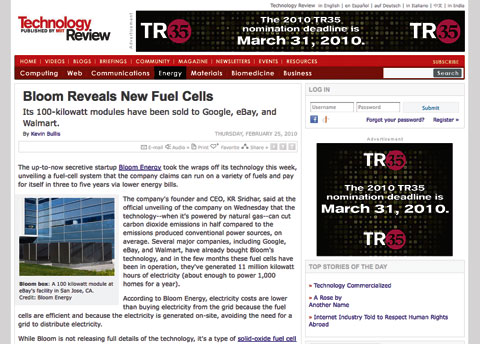According to MIT’s Technology Review, Google, eBay and Walmart have all bought 100-kilowatt fuel cell modules, made by a secretive company called Bloom Energy.
Few technical details have been unveiled, except that the technology applied is known as solid oxide fuel cell (SOFC). These are fuel cells that run on a variety of fuels, natural gas and hydrogen being the most common. They operate at high temperatures and typically have an efficiency of 45 to 50 percent.
“Technically it’s not new”, says dr. Kas Hemmes (Technology, Policy and Management). “But it seems they have made the technology reliable and cheap enough for major data centres to buy into the technology.”
The efficiency is not much better than a modern, large-scale power plant, but it certainly beats smaller scale facilities such as generators driven by gas engines, which reach 30 to 40 percent at most.
Typical ‘challenges’ associated with SOFC’s include leaky sealings, high costs and high operating temperatures. Apparently, Bloom Energy has quietly tackled these issues.
“Their marketing is remarkable as well”, Hemmes says. “Normally a firm presents the technology, highlights their first prototype and hype their developments. Not Bloom. They have quietly worked on the technology, found some well-known customers willing to take the risk, installed the technology, and ran it for months, before bringing it out into the open.”
With their secured power need, data centres are the obvious first clients, just as hospitals could be. The installation allows them to produce their own power cheaper. According to Bloom, the installation pays for itself in three to five years time. Meanwhile, the national power grid serves as a backup.
Bloom sells the fuel cells in 100-kilowatt units. Allegedly for 700,000 US dollars. Units are made of small, tile-like 25-watt fuel cells that can be stacked together. A complete 100-kilowatt module, with multiple stacks and equipment for converting DC power into AC to be used in buildings, is about the size of a parking space. The company says each module can power a small supermarket.”
Bloom says that in ten years’ time the units will also be able to convert energy from solar units or wind turbines. Fuel cell expert, dr. Gaby Jansen, of the Energy Research Centre of the Netherlands (ECN), says these fuel cells can indeed run in reverse, creating hydrogen from electricity. The overall energy efficiency of this process is pretty low (about 50 percent), but then again: wind and sun are for free.
You would expect SOFC to be a popular technology in the Netherlands as well, given the extensive gas infrastructure. But gas is too expensive here, says Hemmes. And power, mainly from coal and imported nuclear, is too cheap. Gas costs about half the price of power for the same amount of energy. “So if you convert gas to power with 50 percent efficiency, you have nothing left for the technology.”
De drinkwaterzuivering in Nederland kan een stuk beter als bedrijfsvoerders gebruikmaken van wiskundige procesmodellen. Dat stelt ir. Kim van Schagen van het Delft Centre for Systems & Control (3mE), die deze week is gepromoveerd op dit onderwerp. De onderzoeker paste wiskundige procesmodellen toe bij de drinkwaterzuivering in Weesperkarspel, wat een besparing opleverde in de hoeveelheid gebruikte chemicaliën. “Met deze aanpak haal je de relevante informatie uit de grote onoverzichtelijke berg aan gegevens over het zuiveringsproces”, zegt Van Schagen. Nu varen bedrijfsvoerders volgens de onderzoeker vooral op ervaring. Ze zouden zich meer moeten laten leiden door objectieve kennis.



Comments are closed.